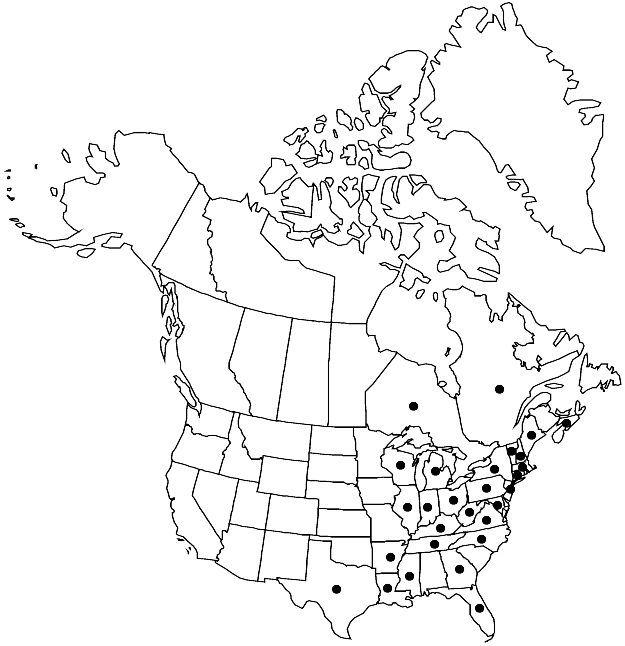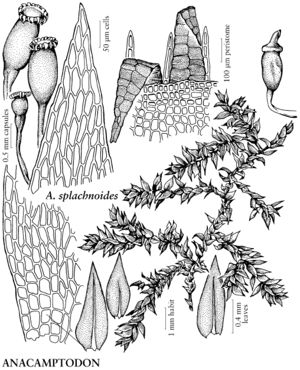Difference between revisions of "Anacamptodon splachnoides"
Muscol. Recent., suppl. 4: 136. 1818.
FNA>Volume Importer |
FNA>Volume Importer |
||
| Line 18: | Line 18: | ||
|name=Anacamptodon splachnoides var. americanus | |name=Anacamptodon splachnoides var. americanus | ||
|authority=Hampe | |authority=Hampe | ||
| − | }}{{Treatment/ID/Synonym | + | }} {{Treatment/ID/Synonym |
|name=Campylodontium hypnoides | |name=Campylodontium hypnoides | ||
|authority=unknown | |authority=unknown | ||
| Line 36: | Line 36: | ||
|elevation=low to high elevations (0-1700 m) | |elevation=low to high elevations (0-1700 m) | ||
|distribution=N.S.;Ont.;Que.;Ark.;Conn.;Fla.;Ga.;Ill.;Ind.;Ky.;La.;Maine;Md.;Mass.;Mich.;Miss.;N.H.;N.J.;N.Y.;N.C.;Ohio;Pa.;Tenn.;Tex.;Vt.;Va.;W.Va.;Wis.;Europe. | |distribution=N.S.;Ont.;Que.;Ark.;Conn.;Fla.;Ga.;Ill.;Ind.;Ky.;La.;Maine;Md.;Mass.;Mich.;Miss.;N.H.;N.J.;N.Y.;N.C.;Ohio;Pa.;Tenn.;Tex.;Vt.;Va.;W.Va.;Wis.;Europe. | ||
| − | |discussion=<p>The habit of Anacamptodon splachnoides, combined with frequent sporophyte production with distinctive, strongly reflexed exostome teeth, makes it one of the more easily recognized mosses. The most common substrates for A. splachnoides are knotholes or wet crevices of Fagus grandifolia and species of Acer and Betula.</p> | + | |discussion=<p>The habit of <i>Anacamptodon splachnoides</i>, combined with frequent sporophyte production with distinctive, strongly reflexed exostome teeth, makes it one of the more easily recognized mosses. The most common substrates for <i>A. splachnoides</i> are knotholes or wet crevices of <i>Fagus grandifolia</i> and species of Acer and <i>Betula</i>.</p> |
|tables= | |tables= | ||
|references= | |references= | ||
| Line 60: | Line 60: | ||
|publication year=1818 | |publication year=1818 | ||
|special status=Selected by author to be illustrated | |special status=Selected by author to be illustrated | ||
| − | |source xml=https://jpend@bitbucket.org/aafc-mbb/fna-data-curation.git/src/ | + | |source xml=https://jpend@bitbucket.org/aafc-mbb/fna-data-curation.git/src/8f726806613d60c220dc4493de13607dd3150896/coarse_grained_fna_xml/V28/V28_445.xml |
|genus=Anacamptodon | |genus=Anacamptodon | ||
|species=Anacamptodon splachnoides | |species=Anacamptodon splachnoides | ||
Revision as of 17:05, 18 September 2019
Plants dull to shiny. Stems creeping, branches ± ascending, straight to slightly curved at apices; somewhat radiculose. Stem and branch leaves erect to slightly spreading when dry, spreading to subsecund when moist; costa to 1/2–4/5 leaf length; laminal cells smooth; basal cells bulging; medial and distal cells 30–56 × 8–11 µm. Perigonia with leaves ovate, apex short-acute, ecostate. Perichaetia with leaves oblong-lanceolate, margins serrulate distally, apex long-acuminate, costa faint, 1/2–3/4 leaf length, laminal cells elongate. Seta yellow, 0.7–1.4 cm, straight. Capsule yellow to brown, 0.8–2 mm, strongly constricted below mouth when dry, hypophysis present; operculum conic, obliquely rostrate; exostome yellow to light brown, teeth paired, strongly recurved when dry, triangular-lanceolate, attenuate, thin; endostome light orange to golden, segments 8 or 16, filiform, elongate, 1/3–1 time exostome length. Calyptra 1.7–2 mm, naked. Spores spheric, finely papillose.
Phenology: Capsules mature (Jan-)Apr–Oct(-Dec).
Habitat: Bark of trees, wet, sheltered niches, crotches, fissures, knotholes on logs, stumps, sometimes rotten, wet rock
Elevation: low to high elevations (0-1700 m)
Distribution

N.S., Ont., Que., Ark., Conn., Fla., Ga., Ill., Ind., Ky., La., Maine, Md., Mass., Mich., Miss., N.H., N.J., N.Y., N.C., Ohio, Pa., Tenn., Tex., Vt., Va., W.Va., Wis., Europe.
Discussion
The habit of Anacamptodon splachnoides, combined with frequent sporophyte production with distinctive, strongly reflexed exostome teeth, makes it one of the more easily recognized mosses. The most common substrates for A. splachnoides are knotholes or wet crevices of Fagus grandifolia and species of Acer and Betula.
Selected References
None.
